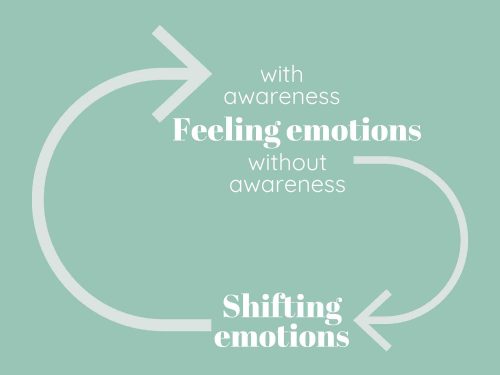If you feel confused about the “right way to handle your emotions”, you’re not alone. We’ve often been taught a reactive way of being with them that includes either avoiding them or being swept away by them. So when we hear the instructions to feel our emotions it might seem very counterintuitive and bring up fear and resistance. On the other hand, we have a sense that this is where the key to unlock our old patterns is hidden.
So is shifting my emotional state a way of suppressing my emotions? And how can I allow them to be felt when that’s what I feel I’ve been doing my whole life – way too much?? In this episode of the Uncover YOU podcast, I bring clarity to these questions and a roadmap to when to practice which skill.
Listen to episode 18 on the difference between Shifting and Feeling emotions here:
A summary of what I cover in the episode:
There was a question…
After the episodes about the Spiritual Ego, and how our mind program might use our skills in shifting out of emotions to avoid feeling them, I’ve noticed a new awareness about the bypassing of feeling emotions in our community. People are exploring the difference between shifting emotions and feeling them.
This question showed up in the community last week:
“I’m a little confused about my beliefs concerning feelings and emotions. Gary has taught us in the SM1 Emotions module that we have the power to invoke good emotions at will simply by using our memory or imagination. Is that possibly a form of suppression or repression (I’m very good at that)?
But today, Eva sent an excellent email about asking ourselves, and I quote, “what am I not allowing “myself to feel” at this moment?” This question is something I’ve been grappling with even before I “met” Gary and Eva. Is there a middle road? Perhaps it’s a matter of convention.
When I’m under the gun and I need to focus on others, as in my teaching practice or my wife and family, is it beneficial to try to put deeper feelings aside and allow the mind to dream up good feelings? I will add this doesn’t always work as I hope it will.
Yet, then when I wake up in the morning somewhat anxious and frustrated and have some time for myself, Is this a good time to ask Eva’s question even though it’s not always pleasant for a time and I could easily distract myself with greener valleys?. What are your thoughts about this?”
An excellent question, with many nuances. I hope I can bring some clarity to it. Let’s start with defining what shifting emotions and feeling emotions mean.
What is Shifting Emotions and what is it good for?
Shifting an emotion, or shifting your emotional state, is the skill of not getting pulled into a habitual emotional reaction but instead making a willful act to shift into a different state.
Underneath this skill, however, is the realization that you have the power to produce any desired emotional state at any time. This realization is crucial if you want to step out of the old victim state where you point to circumstances around you and say: That’s the reason why I’m feeling the way I’m feeling.
Practicing shifting your emotions will help you:
- Shift out from a victim state and empower you to take responsibility for creating your experience
- Notice and shift the perspective you’re in, and notice how the perspective is connected to your emotional state
- Get out of habitual patterns and practice new neural pathways
- Start having more of the emotions you want in your life
A pretty powerful tool huh? Now, let’s look at the skill of feeling emotions and what I mean by that.
What is Feeling Emotions and what is it good for?
Feeling emotions could be done in different ways, so let’s define what they are. Often we’re used to an old way of feeling our emotions, with being pulled into them, overwhelmed by them, and reacting to them and the story they come with.
So lets for simplicity say that feeling emotions could be done in two ways:
- The old way – without awareness
- The new way – with awareness
What I’m referring to as Feeling Emotions as a skill, is to allow your emotions to be felt and released with awareness. Without believing the story that goes with them.
To be able to do this you need to practice other skills, like awareness of your unconscious patterns, un-identification with different parts of your mind, acceptance, relaxation, etc. So no need to beat yourself up if you’re not there yet. It doesn’t mean that you won’t be able to get there.
To fully allow emotions to be felt with awareness will help you:
- Release old stored emotions
- Take apart beliefs that are held with emotions
- Take apart protection mechanisms that has been trying to keep you safe by NOT feeling emotions
- Feel free – less fearful to experience a full range of emotions
- Have a rich experience of life
- Hold space for others while they experience uncomfortable emotions or reactions
Feeling emotions is a major part of being human. The more you unlearn the old program of avoiding them or getting swept away by them, you can enjoy the human experience of feeling them.
Is feeling emotions the same thing as releasing emotions?
So is feeling emotions the same thing as releasing them? It can be, but it doesn’t have to be. Releasing emotions is to allow old emotions that have been held back and stored to surface and be felt without fixing, managing, or going into a fearful reaction about them. This is done by allowing it to be felt while you rest in a calmer sense of yourself and make space for the emotion in your body.
(I guide you through a process of practicing this in the free workshop Being with what is in the Self Mastery Community. Creating an account, if you don’t already have one, to access this workshop is also free.)
But after a while, allowing your emotions to come and go becomes a way of living. There will be new emotions arising, from events in your life, and as you allow them to be felt in the moment they don’t have to be stuffed down and released later.
Feeling your emotions with awareness is the antidote to storing them in your body and having them come up again and again as soon as the same neural pathway, an old wound, is poked.
Now, let’s look at when to practice each one of these skills we’ve been covering.
When to use which skill?
If you’re in a victim state of being swept away by your emotions, or feel scared of them and are keeping up a big wall of protection against feeling them, it makes a lot of sense to start practicing shifting them first. That way you build a sense of agency and control over them first.
When you have started to get some separation from the unconscious program of beliefs that has been running you, it’s a good time to start practice allowing emotions to be felt.
A few important milestones on that journey could look something like:
=> The insight that you are producing your emotions
=> Have strengthened the muscle of shifting your emotional state
=> Feel less identified with the different parts of your mind that are operating from unconscious beliefs
=> Strengthen the skill of releasing emotions
Another way to describe it is that we usually start out in a pattern of feeling emotions without awareness. When we have learned the skill of shifting emotions and practice awareness we can come full circle, back to feeling our emotions, but now WITH awareness.

When you have both skills in your toolbox you’re freer to choose between them throughout your day. Is now a good time to be present with this emotion that is arising, or do I shift my state right now and save it for a meditation later?
When you practice moving between the two skills this way and feel more and more comfortable with being with high sensations of uncomfortable emotions, a new door opens up…
On the other side of feeling emotions…
So where does all of this lead to? Are we feeling emotions as an obligation, as a “should” or a “must”? No, you are practicing feeling emotions to set yourself free from the fear of feeling them, or from being swept away into their world.
I’ll finish with a few lines from the email I sent out the other week:
“When you expand your ability to feel,
also what’s been uncomfortable,
you expand yourself out from the old island of safety.
You’re expanding yourself into freedom.You go boldly into the night of the unknown.
Trusting that love will find you.When you’re not trying to feel happy all the time,
and instead allow yourself to feel anything, everything.
That’s when you set yourself free,
and a joy beyond the safety blanket of happiness can find you.”



